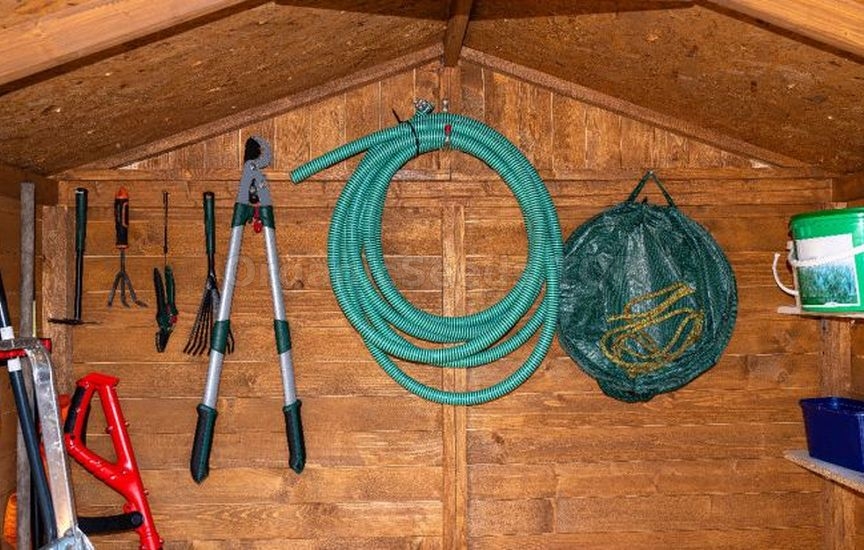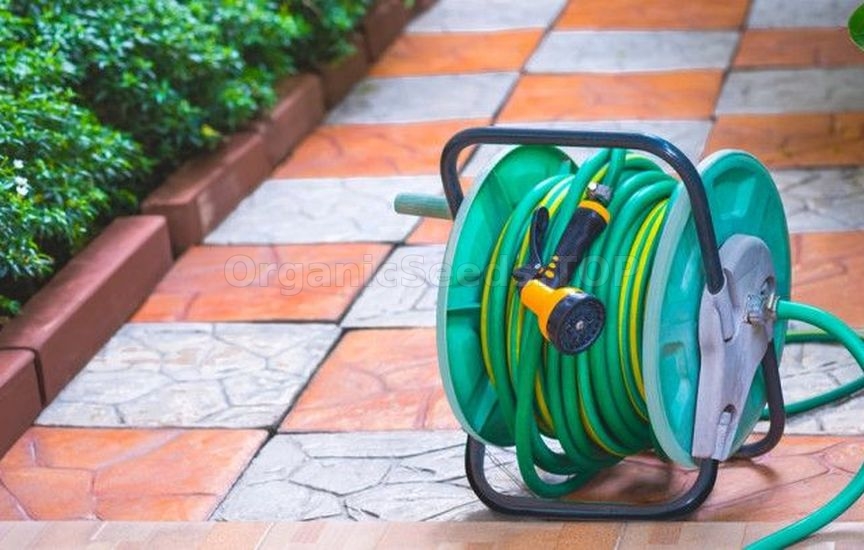How to store hoses, tools, and garden furniture |
To extend the life of garden tools and outdoor furniture, they must not only be used carefully but also stored properly. This issue becomes especially relevant in the fall, after the end of the gardening season.
 How to store hosesHoses are one of the most frequently used tools in the garden and at the dacha. Improper storage can lead to kinks, cracks, and, as a result, water leaks. To avoid these problems, pay attention to the following points when storing the hose.
 First, at the end of the gardening season, the hose must be thoroughly cleaned of dirt and completely drained of all water. Water left inside can freeze and cause the material to rupture, or in warmth, lead to mold and bacteria growth, which will eventually destroy the hose from the inside. Lay the hose out in full length, rinse it with clean water inside and out, and let it dry. Then, after it is completely dry, it is best to coil the hose, but this must be done correctly: untangling a twisted and pinched hose at the beginning of the season is not a pleasant task. Special devices—reels—can help avoid such problems. They come in stationary and mobile versions. Mobile reels are mounted on carts with wheels. This is very convenient, as it allows you to easily move a heavy hose around the site. Winding the hose onto a reel helps prevent kinks and tangling. A simpler but no less effective solution for winter hose storage is wall-mounted brackets. The hose is neatly wound onto such hooks in a figure-eight or circular pattern. In this position, it doesn’t take up much space, is easy to unwind in spring, and is not damaged during storage. If there are no special devices at hand, an old car wheel rim can be used as a reel. The hose is wound around it in a circle, and such a sturdy and stable structure can be placed anywhere convenient. For long-term winter storage, it is best to place the hose in a dry room protected from sudden temperature changes. The plastic and rubber that most garden hoses are made of are prone to degradation under low temperatures, so storing them outdoors or in an unheated shed is not recommended. Storing garden tools Garden tools are the gardener’s main helpers. Shovels, rakes, pruners, and shears require constant care to stay sharp and functional. The first thing to remember is that after each use, they must be cleaned of soil, grass, and other debris. The second is proper storage. A chaotic pile of shovels and rakes in the corner of a shed is common but inconvenient and even dangerous. There are several more effective ways to organize them. Vertical storage is one of the most popular and rational methods. To organize it, you can use wall brackets, a perforated panel, or regular hooks. Long-handled tools are hung by their handles, saving space and making it easy to find and grab the right item. Small tools—pruners, garden knives, trowels—can be placed on hooks on the same panel or on a magnetic strip that securely holds metal items. If wall mounting is not possible, tool racks come to the rescue. These can be ready-made metal or plastic structures or homemade wooden racks with slots. Tools are inserted into these slots handle-down, which also ensures their stability and order. For storing small items—gloves, seed packets, ties—various boxes and organizers are ideal. Transparent containers with lids will protect the contents from moisture and dust, and you can quickly see what’s inside. For long-term storage (e.g., in winter), tools should be additionally protected. Metal parts (blades of shovels, hoes, pruners, etc.) should be oiled after thorough cleaning. They can also be wrapped in cloth soaked in the same oil. These measures help prevent rust. Wooden handles, after being washed and thoroughly dried, should be treated with wax or a special compound to prevent cracking. Before storing tools with plastic parts for the winter, be sure to read the instructions. Not all plastics can withstand severe frost—such tools should be stored in heated rooms. The optimal place for storing tools is a closed room, such as a shed, garage, or specially equipped corner in the house. Tools with rechargeable batteries should be stored in a warm, dry room at a temperature of 5 to 30°C. Batteries should not be left in a room where the temperature drops below 0°C, as this reduces their capacity and leads to rapid discharge. Before storage, tools should be cleaned, and batteries disconnected and stored separately, charged to 50–70%. How to store garden furniture in winter Garden furniture can be made from various materials. Most often, outdoor sets are made of wood, metal, plastic, or woven from rattan and vine. Due to constant exposure to the outdoors, garden tables and chairs are more affected by weather conditions than other dacha items. Rain, sun, snow, and wind can damage wooden and metal furniture, as well as seemingly indestructible plastic structures. Therefore, proper storage of any garden furniture is an important step, as it helps extend its service life. Before storing furniture, it must be thoroughly cleaned of debris, dust, and dirt. Plastic furniture is easy to wash with warm soapy water. Wooden items can be wiped with a damp cloth or soft brush. After completely drying, their surfaces should be treated with protective agents that help prevent damage from temperature fluctuations and moisture. Metal parts should be checked for rust and treated with anti-corrosion agents if necessary. This product should also be applied to areas where rust may potentially appear: chips, scratches, places where the furniture contacts the ground (usually the legs), folding and sliding mechanisms, etc. The most reliable way to preserve expensive wooden, wrought iron, or wicker furniture is to store it in a closed, dry room: a shed, garage, or insulated veranda. If there is no free room, protective covers come to the rescue. This is a great solution for bulky furniture that is difficult to move, as well as for grills, barbecues, and garden fireplaces. Covers should be made of waterproof and breathable materials so that moisture does not accumulate underneath, which can lead to mold. Covers will reliably protect your furniture from rain, snow, UV rays, and dust. If the furniture is collapsible, it is recommended to disassemble it before storage to save space. All bolts and fasteners should be placed in a separate bag so they are not lost before the next season. Plastic chairs can be stacked, making sure they are completely dry. This storage method also helps free up additional space. Soft elements (cushions and covers) should be washed, dried, and stored in a dry and clean place. It is best to pack them in vacuum bags or plastic containers with lids. This will protect them from dust, moisture, and moths. Storing garden tools and furniture is not only about tidiness but also a way to extend the life of useful and beloved items. By spending a little time and effort in the fall, you’ll be able to start the new season easily in spring—with everything at hand and ready to go. |
|
|
